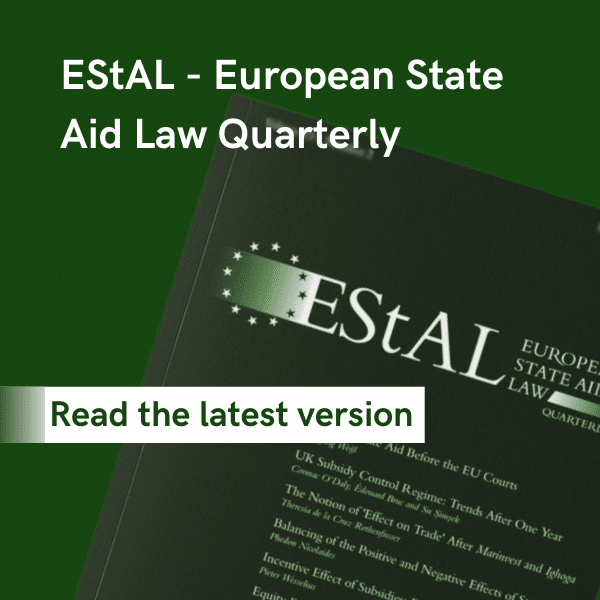
Introduction
The assessment by the Commission of the possible effect of State aid on intra-EU trade can be summarised in the following three-step test whose purpose is to determine whether such an effect is foreseeable [i.e. not hypothetical]:
- the aid must support products or services that are traded, or, in the absence of such a direct effect;
- the recipient undertaking(s) must have activities in other Member States, or, in the absence of such activities;
- the aid must be capable of attracting consumers from other Member States or inducing undertakings from other Member States to establish in the aid granting Member State.
The assessment of all three steps must be negative in order to exclude a non-marginal effect on trade.
In March 2025, the Commission applied this three-step test and concluded in decision SA.108990 that an Italian measure to support local businesses in the area of Valchiavenna did not constitute State aid because trade was unlikely to be affected, despite the fact that Valchiavenna is a border region lying to the north of Lake Como, close to Switzerland. It is a mountainous region with poor transport infrastructure.[1]
The aim of the aid measure was to support small shops so as to prevent further depopulation of the region. As explained in the decision, the Italian authorities sought to “(6) ensure the presence and maintenance of essential local services required to achieve minimum living standards for residents of the local area of Valchiavenna […], and to contribute to the development of the mountain area and maintain population basins in the Alpine area surrounding Valchiavenna.” “(8) Valchiavenna is an entirely mountainous and geographically marginal area, characterised as such due to both the geomorphological configuration and the poor accessibility of the area, as well as the constant loss of local services. According to the Italian authorities, the geographical location of Valchiavenna, right in the centre of the Alpine region, puts it at risk of isolation due to the high degree of hydrogeological instability and poor accessibility.”
“(9) The Italian authorities explain that the Chiavenna Valley can be reached from the rest of Italy by means of a single road, which leads south to Lake Como”. Milan, the largest nearby city is about 125 km away and the journey by road takes between two and three hours, depending on traffic conditions. Valchiavenna is served by a single railway line, without any direct connection to international services.
The population of the region is declining and aging. The vast majority of businesses in the region are classified as “micro”, with fewer than 10 employees. Despite its proximity to Como, Valchiavenna has hardly any tourism infrastructure and does not attract any tourists.
Beneficiaries
The aid measure targeted exclusively micro enterprises and SMEs. The beneficiaries had to “(25) be established and perform their activity in one of the twelve municipalities part of the Comunità Montana della Valchiavenna” and they had to carry out activities that fell in specified NACE codes [e.g. plumbing, car repairs, grocery shops, bakeries].
Duration and form of aid
Since the objective of the measure was to support essential local services and commercial activities, its duration was 15 years.
“(34) The support will take the form of individual grants to the selected beneficiaries. These grants will exclusively cover eligible costs incurred by the beneficiaries for their activities performed within the local area of Valchiavenna.”
The annual budget of the aid measure was expected to be about EUR 1 million, with the overall expenditure reaching about EUR 15 million over the planned 15-year duration of the measure.
It was also noted in the decision that “(37) the Italian authorities have indicated that, while in light of the number of eligible beneficiaries and of the budget of the measure, most of the beneficiaries are expected to receive amounts of aid below the ceiling (de minimis) provided for in Regulation (EU) 2023/2831 of 13 December 2023, it cannot be excluded that during the implementation of the measure, one or several undertakings would receive funding exceeding that threshold. In this regard, the Italian authorities explain that they do not expect more than 15% of the beneficiaries to receive aid above the de minimis ceiling.”
Absence of State aid (no foreseeable effect on trade)
There was no doubt that the measure satisfied at least three of the criteria of Article 107(1) TFEU: use of state resources, conferment of an advantage and support of selected undertakings. The question was whether it also had a non-negligible effect on cross-border trade.
First, the Commission recalled that “(40) as a result of the cumulative nature of these criteria, if any one of them is not fulfilled, the measure does not constitute State aid within the meaning of Article 107(1) TFEU, without it being necessary for the Commission to take a view on whether the rest of criteria are fulfilled or not.”
Then it explained that “(41) public support to undertakings only constitutes State aid under Article 107(1) of the Treaty insofar as it ‘affects trade between Member States’. In that respect, it is not necessary to establish that the aid has an actual effect on trade between Member States but only whether the aid is liable to affect such trade.”
“(42) In particular, the Union Courts have ruled that ‘where State financial aid strengthens the position of an undertaking as compared with other undertakings competing in intra-[Union] trade, the latter must be regarded as affected by the aid.’”
“(43) Public support can be considered capable of having an effect on trade between Member States even if the recipient is not directly involved in cross-border trade. For instance, the subsidy may make it more difficult for operators in other Member States to enter the market by maintaining or increasing local supply. A public subsidy granted to an undertaking which provides only local or regional services and does not provide any services outside its State of origin may nonetheless have an effect on trade between Member States where undertakings from other Member States could provide such services (also through the right of establishment) and that possibility is not merely hypothetical.”
“(44) An effect on trade between Member States cannot be merely hypothetical or presumed. It must be established why the measure distorts or threatens to distort competition and is liable to have an effect on trade between Member States, based on the foreseeable effects of the measure.”
“(45) The Commission has in a number of decisions considered, in view of the specific circumstances of the cases, that the measure had a purely local impact and consequently had no effect on trade between Member States. In those cases, the Commission ascertained in particular that the beneficiary supplied goods or services to a limited area within a Member State and was unlikely to attract customers from other Member States, and that it could not be foreseen that the measure would have more than a marginal effect on the conditions of crossborder investments or establishment.”
Next, the Commission applied the above principles to the case at hand.
“(46) In the present case, the Commission notes that the measure is aimed at providing support exclusively to local micro enterprises and SMEs that perform almost the entirety of their activity (at least 80%) in the local area of Valchiavenna”.
“(47) The Commission further notes that, while being multisectoral, the measure aims at providing support to artisan businesses and local manufacturers, such as electricians, plumbers, mechanics, hairdressers, small clothing boutiques, libraries, drugstores, minimarkets for groceries and beverages, etc […] whose activities are of exclusively and purely local nature.”
“(48) In addition, the Commission notes that the local area of Valchiavenna is an entirely mountainous and geographically marginal area, characterised as such due to both its geomorphological configuration and its poor accessibility. In fact, the Commission notes that the area is recognised as peripheral at national level […] and is hardly accessible from other EU Member States in a reasonable timeframe […] Indeed, the Commission notes that the area lacks public transport infrastructure connecting it with neighbouring Member States, and that the closest border (besides that of Switzerland) is beyond 2 hours and 30 minutes distant from the area (Nauders, Austria). The distance even exceeds four hours considering the closest relevant major city in Austria, Innsbruck.”
“(49) The Commission also notes that, despite being geographically not distant from Lake Como, a highly touristic destination, the area nevertheless remains rather remote and unlikely to attract tourism. First, the Commission acknowledges that the closest tourist hub (Menaggio) is distant more than one hour from Valchiavenna, and that Lake Como’s main city (Como) is distant approximately two hours from Valchiavenna […] Second, the Commission notes that the only ski resort present in the territory of Valchiavenna is of purely local nature and therefore not liable to attract any meaningful number of skiers from the surrounding region, let alone skiers from other Member States”.
“(50) Furthermore, the Commission notes that, in light of (a) Valchiavenna’s accessibility issues and distance from reference services and hubs, of (b) its geographical and hydrogeological constraints, (c) of its tendency to depopulation and population ageing, as well as of (d) its loss of productive fabric over the recent years […], the area is structurally unfavourable to new businesses, especially from other Member States, and is very unlikely (if at all) to attract investments from other Member States.”
“(51) Finally, even though the relatively small amount of aid or the relatively small size of the undertakings which receive it does not as such exclude the possibility that trade between Member States might be affected, the Commission notes, nevertheless, that the amount of individual aid will be, for the majority of undertakings concerned, particularly limited and potentially below the de minimis threshold […] This relatively small amount of individual aid is to be considered together with the local scope of the economic activities pursued by the beneficiaries and the nature of the services provided.”
“(52) In view of the above considerations, the Commission makes the below observations.”
“(53) First, the intended beneficiaries exclusively supply services or goods to a limited (local) area within Valchiavenna (Sondrio province) and are unlikely to attract any meaningful number of customers from other Member States, both in light of nature of the goods and services supplied and of the remoteness and low accessibility of the territory in which they provide their services. The potential beneficiaries serve predominantly (if not exclusively) local users, thereby limiting competition for the services offered to a local level, and for which the impact on cross-border investment is no more than marginal.”
“(54) Second, in light of the nature of goods and services supplied and of the geomorphological constraints of Valchiavenna as well as its low connectivity, it is unlikely that competing undertakings established in neighbouring Member States would be interested in providing similar services in the area concerned. Hence, absent any interest from the latter, it is unlikely that the measure would have any impact (other than merely hypothetical or presumed) on their ability and willingness to enter the market.”
“(55) Third, the Commission considers that, in view of the high number of potential beneficiaries (more than 500) spread across 12 municipalities, compared to the rather limited budget of the measure (EUR 1 million per year), it is highly probable that for most of the beneficiaries the individual aid amount will not exceed EUR 300 000 over any period of three years, in line with Regulation (EU) 2023/2831, and may therefore be deemed not to have any effect on trade between Member States and not to distort or threaten to distort competition.”
“(56) On the basis of the above considerations, the Commission concludes that the measure, as notified by the Italian authorities, could not be foreseen to have more than a marginal effect on the conditions of cross-border investments or establishment and therefore no more than a merely hypothetical or presumed effect on trade between Member States.”
[1] The full text of the Commission decision can be accessed at:
https://ec.europa.eu/competition/state_aid/cases1/202512/SA_108990_61.pdf



